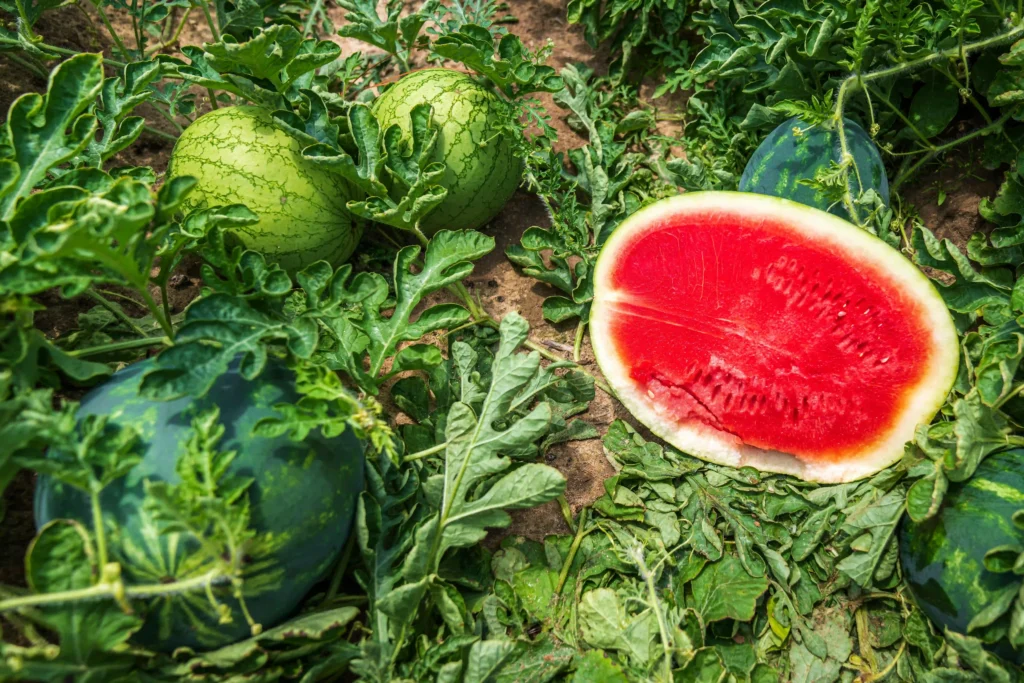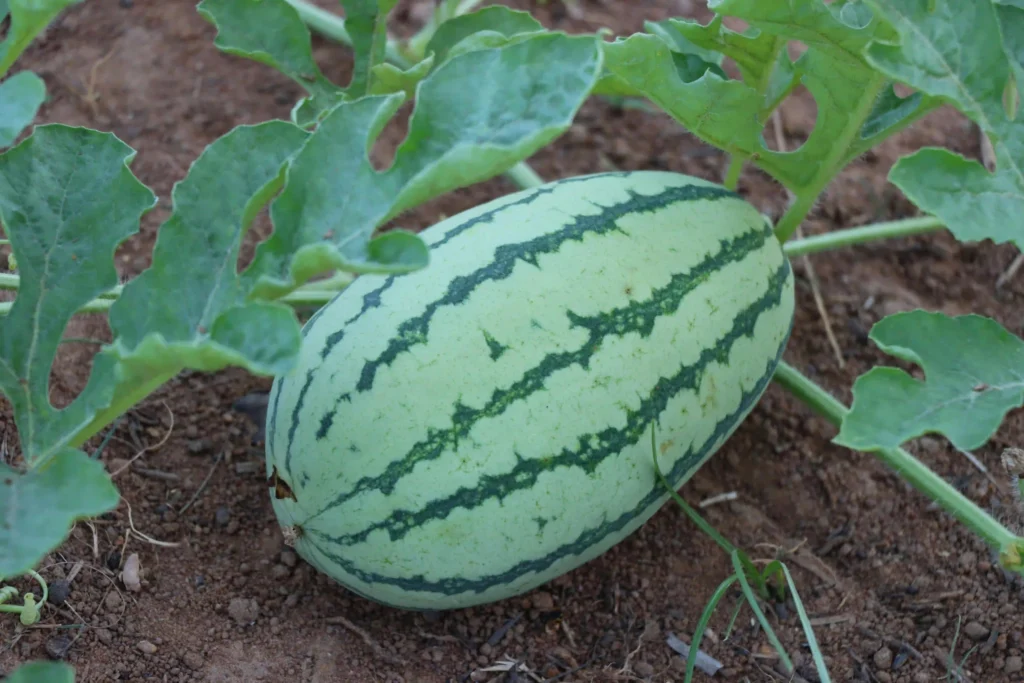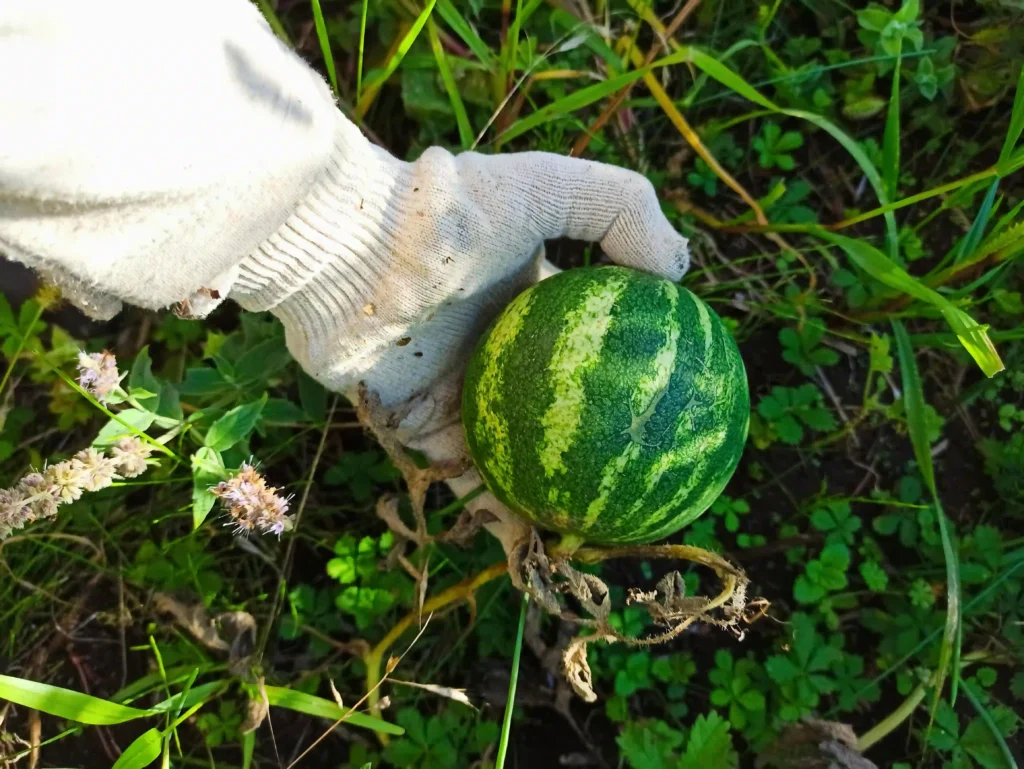Introduction: Growing Your Own Watermelons for a Sweet Harvest

The practice of growing watermelons at home yields delicious summer fruits that become available when summer arrives. A successful watermelon crop depends on proper selection of varieties in addition to correct amounts of sunlight and both water and nutrients. Proper implementation of well-defined procedures will help you grow wholesome plants which lead to abundant yields. Now we will see How to Plant Watermelon in Your Garden.
Table of Contents
1. Selecting the appropriate watermelon type is fundamental for garden cultivation.
Watermelon plants appear in multiple dimensions and breeding types which vary across sweetness levels and skin coloring. Some common varieties include:
- Seedless Watermelon demands a pollinating plant to create its unique sweet seedless fruits.
- The Sugar Baby produces a round and early maturing watermelon with small proportions.
- Crimson Sweet – Known for its bright red flesh and high sugar content.
- Charleston Gray – A large variety with excellent disease resistance.
- Yellow Flesh Watermelon – Offers a unique, sweet flavor with a yellow interior.
Select a watermelon type which suits your geographical location alongside the space constraints and personal taste.
2. Best Time to Plant Watermelon: Understanding the Growing Season
The warm climate during summertime is crucial for watermelons and these plants need a prolonged period to grow. Plants of watermelon require the perfect planting soil requirement before beginning their growth cycle based on local weather patterns.
- Temperatures consistently above 70°F (21°C).
- Plants must go into the ground during the second to third weeks after the complete elimination of frost risks.
- Conduct seed planting indoors during the period of 3-4 weeks before doing outdoor transplants if you reside in cooler regions.
Ownership of watermelons requires an 80-100 day growth period thus planting them at proper times will help them mature just before the initial autumn frost arrives.
3. Selecting the Ideal Location: Soil, Sunlight, and Space Requirements
A successful watermelon planting site requires the following conditions at the location:
- Full Sun – Watermelons need at least 6-8 hours of direct sunlight daily for optimal growth.
- The right soil for watermelons should be sandy loam because it offers both excellent drainage and prevents waterlogging and root rot.
- The best soil pH range for proper nutrient absorption measures from 6.0 through 6.8.
- Watermelon vines grow 6-10 feet across thus you need to plan for the appropriate area of distribution.
Light or high-density watermelons with compacted bush habits can be selected as an alternative for restricted planting areas.
4. Preparing the Soil: Nutrients and pH Levels for Healthy Growth

Watermelon plants require proper soil preparation as a necessary step for developing their strength and producing high yields. Follow these steps:
- To enhance root development you should loosen the soil down to 12 inches deep.
- For higher soil fertility you should blend organic matter with aged manure into the bed.
- A test of the soil should be conducted to determine proper pH adjustment by adding sulfur or lime for raising or lowering pH levels.
- Construct your soil with organic substances which will keep the moisture in yetSupply adequate drainage at the same time.
- Sow watermelons using fertilizer having equal amounts of NPK (10-10-10) before seed planting.
The growth of healthy watermelon roots alongside superior fruit production depends on having soil with proper nutrient content.
5. Planting Watermelon Seeds vs. Transplants: Which One to Choose?
Watermelon seeds along with transplanted watermelons work for plant cultivation.
• Seeds:
- You should plant seeds one inch deep into the soil the moment frost danger ends.
- Plant two or three seeds together in each hills at a distance of 3 to 5 feet between plants.
- Thin to the healthiest seedling after germination.
• Transplants:
- Plant watermelon seeds inside your home during the period of 3-4 weeks until they are ready for outdoor transplantation.
- Using biodegradable seed pots helps decrease the negative impact on plant roots which causes transplant shock.
- The process of allowing seedlings to become accustomed to outdoor conditions before actual garden planting should be performed.
Seeds work best in warm weather areas while transplants provide a time advantage during cold seasons.
6. Proper Spacing and Depth for Watermelon Plants
Good air circulation together with disease reduction and healthy growth becomes possible when plants receive the correct amount of space gap between them. Follow these spacing guidelines:
- The proper spacing for planting watermelon seeds using Hills Method includes seeding two to three seeds in each hill with 4 to 6 feet separating the hills from one another.
- The Row Method requires planting watermelon plants at 2-3 foot distances within rows that maintain 6-8 feet separation between each row.
- Watermelon trellis systems require small varieties that should be arranged 2 feet apart with vine support throughout their growth.
For optimal fruit production keep watermelons well separated from each other since they need space for healthy expansion.
7. Watering Needs: How to Keep Your Watermelon Plants Hydrated
Watermelons need regular watering throughout their entire life cycle beginning from development until their final stage of fruit growth.
- The act of deep watering for approximately one to two inches per week helps develop robust roots.
- Send water down at the plant base to avoid fungal infections.
- Wet leaves will develop diseases so always water at the base of the plants.
- Smooth and sweet watermelon develops best when you reduce water during fruit ripening to avoid cracking.
Plant mulching keeps the soil moist while it controls temperature fluctuations.
8. Fertilizing Watermelon Plants: What Nutrients They Need
For vigorous growth together with successful fruit production watermelons require adequate nutrient proportions in specific amounts:
- The early growth stage of watermelons requires high-nitrogen fertilizer at 20-10-10 percentage to produce leaves and develop vines.
- Apply a 10-20-20 fertilizer to the plants in the flowering stage and fruiting phase for better flowering outcomes.
- Plant nutrients are supplied through slow-release sources by using compost along with fish emulsion combined with bone meal.
The application of high amounts of nitrogen after flowering should be avoided because it leads to increased vine development instead of improved fruit production.
9. Mulching and Weed Control: Keeping the Soil Moist and Clean
The procedure of mulching serves as a vital component for sustaining vigorous watermelon plant health.
- The practice helps soil retain water which leads to fewer watering sessions.
- The cover suppresses weeds therefore they do not compete with plants for essential nutrients.
- Hot weather conditions benefit from the root-cooling effect that soil regulating heat provides.
- Watermelons stay protected from soil diseases since mulch creates a physical barrier between soil and plant.
Straw and grass clippings and black plastic mulch work best as organic mulch materials to achieve optimal benefits.
10. Managing Pests and Diseases: Protecting Your Watermelon Plants
Watermelons face various pests together with diseases which can cause damage to their growth. Here’s how to manage them:
Common Pests:
- Aphids – Use insecticidal soap or neem oil.
- You can manage Cucumber Beetles by picking them by hand while row covers serve as another effective pest control option.
- Spider Mites require a water-based leaf wash to eliminate them.
Common Diseases:
- Powdery Mildew requires proper ventilation while you may need to use a fungicide if needed.
- Plant watermelons in different crops successively while selecting varieties that resist Fusarium Wilt.
- Regular water supply from above can lead to anthracnose development so replace it with ground-level irrigation and discard affected plants from the field.
Investing time to periodically examine plants and practicing natural pest management practices results in healthy vine development.
11. Supporting Vine Growth: Tips for Managing Sprawling Plants
Watermelon vines tend to expand in wide dimensions hence appropriate growth management becomes necessary.
- Vines need training according to a proper direction to achieve organization.
- Trellises allow cultivation of small watermelons without using excess garden space.
- Regulate overgrown vines by removing them to place plant energy on fruit development.
- Asthma-like bedding made of straw or cardboard should be placed under ripening fruits to stop rot development.
Manage the vine system properly and you will achieve more robust fruits with higher productivity rates.
12. Pollination: Ensuring a Good Fruit Set for Maximum Yield
The developmental process of watermelons requires pollination as its fundamental step. Follow this approach to achieve proper pollination:
- People should plant flowers near their bee habitat to attract pollinating insects.
- Plant breeders should use a short brush to move pollen grains between male and female watermelon flowers for pollination.
- The use of pesticides that may impact pollinating species should be completely avoided.
Watermelons which receive proper pollination grow into bigger and healthier fruit forms.
13. Signs of Maturity: How to Tell When Watermelons Are Ready to Harvest
Checking ripeness of watermelons helps you achieve optimal taste quality with perfect texture. Look for these signs:
- When immature watermelons reach maturity their brown-colored tendril alongside the fruit will start to shrivel.
- The ground spot beneath the watermelon turns from white into a yellow hue.
- A fresh watermelon makes a deep reverberating tone after you touch it due to its ripe state.
- The surface of the watermelon turns tough and develops resistance to simple touch.
Professional harvesting during the appropriate period leads to the maximum sugar content in your watermelons.
14. Harvesting Watermelon: The Right Technique for the Perfect Pick

The process of proper harvesting helps to maintain fresh and intact watermelons:
- Garden shears or a knife will perform the tasks of cutting the fruit away from the vine.
- Reserve a small section of the stem following the harvest to stop premature rotting of the watermelon.
- Slow handling movements are necessary because rough treatment might damage the watermelon flesh.
Harvest watermelons when they have reached their full maturity since these fruits do not develop further ripeness after being cut from the vine.
15. Storing and Enjoying Your Homegrown Watermelons
The correct method of storing watermelons after harvest helps maintain their freshness:
- You can store whole watermelons at room temperature along with proper dry storage conditions for a period of 10 days.
- The proper storage method for cut watermelons includes placing them in a sealed container while they remain fresh for 3 to 5 days.
- Freezing requires turning watermelon into juice or puree before storage as smoothie or popsicle ingredients.
You will achieve the best chilling refreshment from watermelons when you eat them right after harvesting.
16. Common Mistakes to Avoid When Growing Watermelon
The following list of mistakes should be avoided for achieving successful watermelon harvests:
- The process of watermelon development can be harmed by such mistakes as excessive irrigation alongside insufficient watering.
- The practice of too early planting creates the risk of cold damage to the plants.
- Poor airflow and plant overcrowding develop due to disregarding required space between plants.
- Fruitless vines result from neglecting to check for pollination.
- Picking the melons before maturity will yield underdeveloped tasteless produce.
Implementation of proper industry standards leads to the highest possible watermelon production rates.
Conclusion: Enjoying the Fruits of Your Labor
Growing watermelons in your garden needs careful attention and patience results in satisfactory returns. Succulent summer watermelons become possible when you execute the correct planting methods along with regular watering and feeding with proper pest protection measures. Fresh consumption and blending into beverages and addition to plates are the best ways to savor your homegrown watermelons which will exceed all other watermelon flavors. You can also learn about Foods That Are Super Healthy.